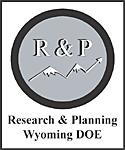Measuring Job Satisfaction
of Public Health Nurses
in Wyoming
Inside the Report
- What is a Public Health Nurse?
- Critical Functions
- Retirement Concerns
- Average Age by Region
- Regional Age Distribution
- Description of Sample
- Response Rate
- Age and Demographics Distribution
- Education Distribution
- Tenure Distribution
- Results
- Satisfaction
- Intention to Leave
- Why Would You Leave Nursing?
- Longevity
- Starting Work in PHN
- Staying in PHN
- Conclusions
In 2002 and 2003, Research & Planning conducted research to study work force behavior of nurses in Wyoming. This research, which used administrative databases including Board of Nursing files, yielded information on retention, turnover, and other transition behaviors. While the data were useful to the nursing community, more information was required to fully understand the issues facing Wyoming nurses.
The objective of this research was to enhance retention and supply strategies as the current population of baby boom generation nurses advances toward a traditional retirement age. Prior nursing studies have been used to seek funding to implement these strategies. However, the time between research and retention strategy implementation may be a period of years, making it difficult to directly link research to outcomes.
Through feedback by a nurse advisory council, the Wyoming Hospital Association, the Wyoming Long-Term Care Association, the Wyoming Healthcare Commission, Wyoming Medical Center staff, and members of the nursing community at statewide nursing summits, R&P initiated a three-faceted approach to study nurse behavior.
In 2007, two groups of nurses were surveyed: nurses working in ambulatory care (includes private doctor’s offices and surgery centers) and nurses working in hospitals and long-term care centers.
It was decided that a questionnaire should be developed for public health nurses because they are dissimilar to both groups previously surveyed. State Public Health Supervisor Karen Ouzts served as the project’s advisor as the goals of the research were identified and the questionnaire was modified.
The questionnaire previously used for hospitals and long-term care facilities was nearly identical to the questionnaire for ambulatory care. The difference was the addition of questions regarding overtime and shift changes. As public health nurses typically work a standard daytime schedule, it was decided to base the questionnaire on the form used to survey nurses working in ambulatory care. Questions regarding satisfaction (overall satisfaction with workplace issues, overall satisfaction with the nursing occupation, and satisfaction with the community) were left unaltered. Questions about education, tenure, and motivation for working in public health were added.
On September 19, 2008, all Wyoming public health nurses were mailed an advance letter to their home address in order to inform them of the upcoming survey. The mailing also served as a form of address refinement. The final response rate was 83.4% (136 returned questionnaires) after two mailings.
Responses to questions about workplace satisfaction showed that public health nurses were more satisfied than were nurses working in hospitals and long-term care facilities (see Table). Nearly three-fourths (74.1%) of the responses to the workplace measures were statistically different. All of the statistically significant differences indicated higher levels of workplace satisfaction among the public health nurses than the levels stated by nurses working in hospitals and long-term care facilities and ambulatory care.
Of the 136 who returned questionnaires, only 7 stated they planned to leave their job within a year; of those, 3 said they were planning to retire.
When asked about factors that would influence a decision to leave nursing entirely, nurses in public health were more likely than nurses in ambulatory care or hospitals and long-term care to select “I plan to retire,” “I feel burned out from nursing,” and “Better work schedules outside nursing.” However, they were less likely to select “Feel overworked, “I need more autonomy,” and “Better work schedules available outside nursing.” They were also less likely to leave because of concerns about injury, either to self or patients.
For more information, see the full report at http://doe.state.wy.us/LMI/phn_09/title.htm.
| Table: Stated Satisfaction Levels of Nurses Working in Public Health | |||
| Public Health | Hospitals & Long-Term Care Facilities | Ambulatory Care | |
| Overall satisfaction | 4.1 (a) | 3.6 | 3.9 |
| Professional Development factor | 3.8 (a,b) | 3.5 | 3.5 |
| Interpersonal factor | 4.1 (a,b) | 3.7 | 4 |
| Compensation factor | 3.6 (a,b) | 3.1 | 3.2 |
| Non-Nursing Tasks factor | 3.6 (a,b) | 3 | 3.3 |
| Local Economic Conditions factor | 3.4 (a,b) | 3.3 | 3.3 |
| Community Services factor | 3.2 | 3.4 | 3.3 |
| Disposable Income factor | 2.6 | 2.7 | 2.8 |
| (a) Significantly more satisfied than nurses working in hospitals and long-term care facilities. | |||
| (b) Significantly more satisfied than nurses working in ambulatory care. | |||
